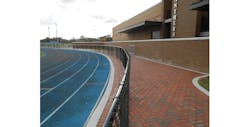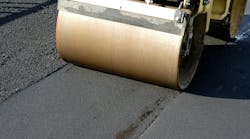In the Shadow of the Storm
In Pascagoula, Miss., planners are looking toward the future while remembering the past.
A new installation of StormPave pavers was installed around the ticket booths and in an area between a field house, a running track and a parking lot at Pascagoula High School.
The pavers, from North Carolina-based Pine Hall Brick Company, were used next to a pervious pavement parking lot and were intended to help resolve a problem with standing water after heavy rains.
The pavers, which appear similar to conventional clay pavers, are installed atop carefully layered aggregates. Storm water infiltrates between the pavers and is held in the aggregates before seeping into the ground, where it is naturally filtered.
The construction—which is part of a $3.5 million upgrade to Pascagoula High School for a new football field house and work to the ticket booth and parking lot—was undertaken with the still-fresh memory of one of the worst storms in American history.
Unlike many places in the United States, Pascagoula and the area that surrounds it has good reason to be concerned with storm water runoff.
In August 2005, Hurricane Katrina came ashore, bringing with it a storm surge of between 16 and 18 ft in the part of Mississippi that sits adjacent to the Gulf of Mexico. Overall, Hurricane Katrina caused a reported 1,833 deaths, $108 billion in property damage and damage to a land area roughly the size of Great Britain.
Within Pascagoula itself, a reported 95% of houses—along with stores, churches, schools, roadways and everything else—were damaged by the floodwaters.
Jason Buckley, RLA, a landscape architect with JBHM Architecture in Jackson, Miss., said that the immediate need was to make certain standing water would not migrate onto the running track. Beyond that, Buckley said, officials in the areas hit hardest by Hurricane Katrina are now more concerned than ever before about any solid surface on the ground.
“This is in an area where we could not have any more solid surface,” said Buckley. “Post-Katrina, they are sensitive about impervious surfaces, and that is what led us to use this product.”
He noted that the goal throughout the region is to decrease any further use of solid surfaces such as conventional asphalt and concrete, and increase the use of permeable surfaces such as segmental permeable paving and the like, should a storm the size of Katrina come ashore again.
“This really changed the game,” said Buckley. “We’re looking for a zero increase in runoff here and to increase impervious surface to contain the drainage.”
Walt Steele is paver business manager for Pine Hall Brick Co. Steele can be reached at [email protected] or 800.334.8689.


